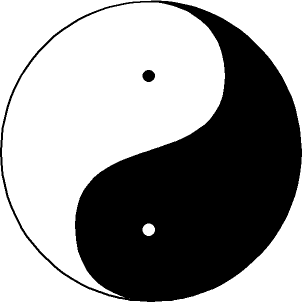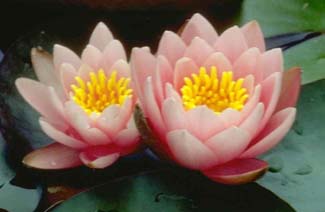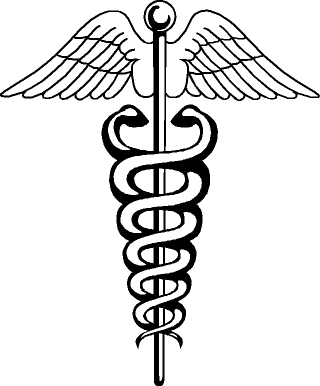
There is something special about symbols -- the way they catch our attention, awaken memories, preserve and reveal truths without a word being said. As a matter of fact, symbols are a philosophic shorthand that has been inscribed on clay tablets, carved into stone, painted on temple walls and, millions of years ago, impressed by wise and godlike beings into the consciousness of mankind. In doing this they assured us of guidance: we have but to turn within "where truth abides in fullness" to find direction, answers to our problems, and inspiration. For, as psychiatrist Roberto Assagioli observed, every symbol generates "a dynamic psychological charge or voltage" that stirs our souls.
What are some of these symbols? There are geometric forms, such as circles, spirals, crosses, triangles; and natural objects like stars, trees and flowers, soaring birds, and coiling snakes. Each in its own way condenses truths about the laws and operations of cosmic and human life. H. P. Blavatsky found such depth of meaning in them that she used symbols as the basis of the cosmogenesis and anthropogenesis she presented in The Secret Doctrine. In its Proem she writes:
An Archaic Manuscript -- a collection of palm leaves made impermeable to water, fire, and air, by some specific unknown process -- is before the writer's eye. On the first page is an immaculate white disk within a dull black ground. On the following page, the same disk, but with a central point. The first, the student knows to represent Kosmos in Eternity, before the re-awakening of still slumbering Energy, the emanation of the Word in later systems. The point in the hitherto immaculate Disk . . . denotes the dawn of differentiation. It is the Point in the Mundane Egg, the germ . . . which will become the Universe, the all, the boundless, periodical Kosmos, this germ being latent and active, periodically and by turns. The one circle is divine Unity, from which all proceeds, whither all returns. Its circumference . . . indicates the abstract, ever incognisable presence, and its plane, the Universal Soul, although the two are one. Only the face of the Disk being white and the ground all around black, shows clearly that its plane is the only knowledge . . . that is attainable by man. It is on this plane that the Manvantaric manifestations begin; for it is in this soul that slumbers, during the Pralaya, the Divine Thought, wherein lies concealed the plan of every future Cosmogony and Theogony. -- The Secret Doctrine 1:1
Then, taking several circles -- a white disk, and circles with a dot, a horizontal line, a cross, and a swastika inside -- she expands their meaning and describes in fascinating detail the creation and evolution of worlds and men.
Similar ideas have been preserved and revealed in the symbols of many religious, philosophical, and scientific systems, as well as in myths, architectural designs, and sacred rituals. The circle, one of the simplest and most profound symbols, can be found everywhere: in the shape of the sun, moon, and planets, and of various fruits; and by extension, in our circle of friends, activities, and in the cycles of the day, the seasons, and centuries. No wonder a circle is one of the first things a child draws when given a crayon! Such circles have many meanings: they suggest containment, the fullness of space, a womb, and hence the Great Mother or source of all being; and thus eggs, like the Egg of Brahma, and arks such as those of the Biblical Noah and the Zoroastrian Yima.
From another perspective, circles suggest unity, brotherhood, oneness: there is no first or last, no bounds, difference, or division in a circle. All partake of its oneness, all are one with the Whole. To some people, the dot within the circle suggests the heart-center where peace, love, and solutions can be found. For others, it represents the point or passageway through which all forms of life appear and later disappear into invisibility.
Scientists symbolize the sun by a circle with a central point, and many religions regard it as a god or goddess whose divine life and light radiates in all directions. An early Christian hymn reflects this idea:
O thou true sun
Shining with perpetual light!
Image of the holy spirit
Infill us full.
In Norse mythology the sun is a goddess who vanishes every night into darkness, and will, along with the rest of her family, vanish completely at the end of the life cycle. During the long night that follows, she will give birth to a daughter-sun.
In ancient times, people of many lands participated in sacred dances honoring the sun and its planets by imitating their harmonious movements. They believed, perhaps, that in this way they united themselves with and benefited from cosmic and solar forces. The wisest among them may have known that the sun is a spiritual being, the parent or hierarch of its vast system. From it radiate the spiritual, intellectual, and vital forces that keep our world in balance and which, on the human level, inspire those who become our great teachers and kings. Sons of the Sun they truly are!
Using a circle to portray the duality in nature, the Chinese devised the yang/yin symbol by dividing the circle in two: half black, half white, with a small circle of the opposite color in each section. With this they depict the balance of opposites -- of light/darkness, spirit/matter, activity/rest, birth/death, health/illness, and also the fact that every condition and stage of life holds potential. Periods of darkness, depression, and pain hold a promise of light, hope, and opportunity. Periods of light and happiness contain shadows. Nothing endures forever: the great wheel of life cycles onward through endless duration.

Wheels, as variants of the circle, are found around the world: prayer wheels, Wheels of the Law (that is, of the inevitable return of karmic consequence), wheels of life upon which all beings progress through alternating stages of duration, mandalas and medicine wheels that are still used for healing and teaching. The ancient Etruscan goddess Vortumna, "who turns the wheel of the year," is reflected in the Roman goddess Fortuna who oversaw the administration of the three aspects of karma: past, present and future.
Myths and stories can be symbols too. Bards of old, recognizing their cathartic effect, related allegorical tales before an open hearth or campfire out under the stars. Such settings, combined with the cadence of their voices, and the repetition of particular sounds and phrases, stimulate reverie and awaken memories stored in our souls. And so can words, which are symbols themselves, with many levels of meaning. In many languages, the letters of the alphabet have numerical and astronomical correspondences. Speakers and writers are often aware that words are like seeds, encapsulating thoughts accumulated by the minds that entertain them and in this way changing and developing.
A favorite symbol among the peoples of Egypt and India is the lotus, which we find featured in art, stories, hymns, and mantras. For example, the Sanskrit Om mani padme hum means, "Om, the jewel in the lotus." Mani, the "jewel," refers to the spark of divinity that is within the heart of every living being, and from which we receive inspiration, our feelings of love and yearnings to grow greater. The lotus refers to the gradual unfoldment of our inner being in manifested life, whether on a small or grand scale. Between the divinity in atom, man, and cosmos, the difference is only in degree of expression. Throughout there is the same life, the same consciousness, the same laws.

Reflecting this thought, the Maitri Upanishad explains:
Now, that golden Person who is within the sun, who looks down upon the earth from his golden place, is even He who dwells within the lotus of the heart [of man] . . .
He who dwells within the lotus of the heart . . . is the same as that solar fire which dwells in the sky. -- 6:1-2
For this reason, as G. de Purucker once explained to his students,
All spiritual illumination comes to you now, and ever will come to you, from the Master within yourself. There is no other possible pathway to the light. All growth is from within; all illumination is from within; all inspiration is from within; all initiation is from within. -- Golden Precepts of Esotericism, pp. 131-2
We find this idea proclaimed throughout nature: a lump of coal becomes a diamond, a caterpillar a butterfly, a seed a tree, and men become the god within.
Trees are powerful symbols found in many scriptures. In India, it was under the Bodhi or Wisdom Tree that Prince Siddhartha became enlightened and conceived the Noble Eightfold Path by which human beings can free themselves from the suffering of old age, disease, and death. The Bible has its Trees of Life and of the Knowledge of Good and Evil. The Zoroastrian scriptures tell of the tree that rose from the sea on the first day of creation, and which contained and dispersed the seeds of all life. Even scientists have used the tree to symbolize the relation of various forms of life to each other and to their origins.
The Hebrew Sephirothal Tree of Life is also a Tree of Knowledge, in that it reveals the divine plans of the creation, and operations of cosmic and human life. And so, in its way, was the Parijata tree that Krishna planted in the center of his "wonder city," and whose fragrance perfumed the land all around and enabled those who approached to remember a previous existence. However, when Krishna died, the tree "ascended to heaven" which, the Vishnu Purana suggests, implies that esoteric teachings were freely given during Krishna's life, but when he departed, they were imparted only in private.
And what about Christmas trees: have you ever wondered why we delight in buying and decorating evergreen trees at Christmas time? Could it be because we sense that the Christmas tree represents the World Tree, with its roots in the realms of spirit and its branches in realms of matter? The ornaments and lights are emblems both of the great ones who illumine our lives, and of the suns and planets that bestrew the spaces of space, and whose light of love, mind, and hope eternal reaches and enriches our lives.
Some symbols unfortunately have been debased. The serpent, for instance, once signified the holiest and wisest of men and the truths they possessed. In Europe Mercury/Hermes, the winged messenger of the gods and benefactor of mankind, carried a caduceus, a staff upon which two serpents entwine, a symbol adopted by physicians the world over who dedicate their lives to healing others.

Druids called themselves snakes, while in Mexico, Quetzal-Coatl, the "feathered serpent," was a sun god. Why would gods, or any being more advanced than we, be symbolized as a serpent? Perhaps to indicate that their knowledge encompasses the "three worlds" -- the sensual, intellectual, and spiritual -- suggested by snakes that live in underground caverns, on land and in water, and in tall trees. They indicate, by shedding their skins, renewal and transformation; and by their coiling, recurring cycles and the spiraling forces of nature, which we observe in tornadoes, vines climbing a pole, in the circular patterns of shells, flowers, and the Great Spiral Nebula. Even the "Great Serpent," Satan, may be viewed as a symbol of those periodic temptations and difficulties which foster our growth and awaken our souls.
Another corrupted symbol is the swastika (Sanskrit, ``well-being'') which, combining the circle and cross with bent arms, is an emblem of ceaseless, eternal motion, and of the celestial forces that cycle down from the four cardinal points and quarters of space to affect our lives. Used the world over from the most ancient times, it is found for example in pre-Columbian America, Mesopotamia, and the Indus Valley civilization. It also appeared frequently in the Catacombs as a symbol of Christ, and in medieval Europe signifying Christ as the cornerstone. Swastikas indicate that change is the law of laws; everything moves forward to higher attainments and greater expression.
All these symbols, and many we wear as jewelry and use as business logos, are keys which, if considered thoughtfully, can open before us the "secret doctrine" of the ages, as they did for H. P. Blavatsky when she studied the symbols on that archaic manuscript which had been preserved for millennia. With figures as simple as a circle, cross, and triangle, and their variations, she presented to the world not only a magnificent history of human and cosmic evolution, but also a vision of our present and future possibilities.

(From Sunrise magazine, June/July 2000; copyright © 2000 Theosophical University Press)
In our present stage of evolution the qualities of self-forgetfulness and true love of humanity are all too slightly apparent. But we need not feel discouraged, for nature's way is constantly to urge toward their development, if need be through suffering and pain. And if we consciously live our lives in such a way that they are a blessing to our fellow men, we shall find that spirituality will appear as naturally and as quietly as the flower opens its petals to the warming rays of the sun.
Man in his inmost is immortal and divine, a spark from the highest spiritual force in the universe. As Herbert Spencer phrased it: "Among the mysteries that become stranger the more we think about them, there will always be mentioned our absolute certainty that we are in perpetual contact with an infinite energy from which all things have emanated."
Herein lies the proof of universal brotherhood -- linked as we are by unbreakable bonds, units in diversity. Through our connection with the highest spiritual powers of the universe, the possibilities for development are limitless. -- Peter Flach